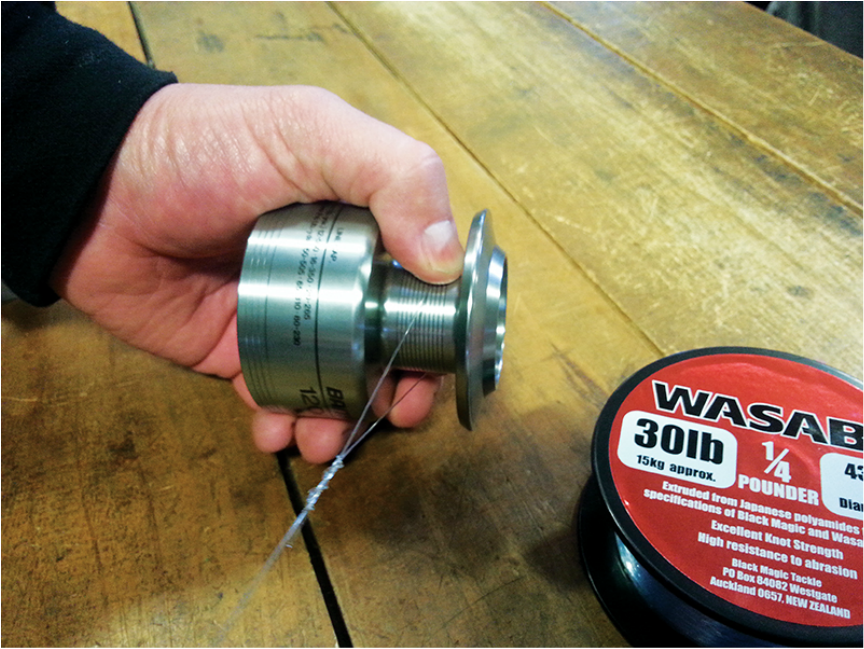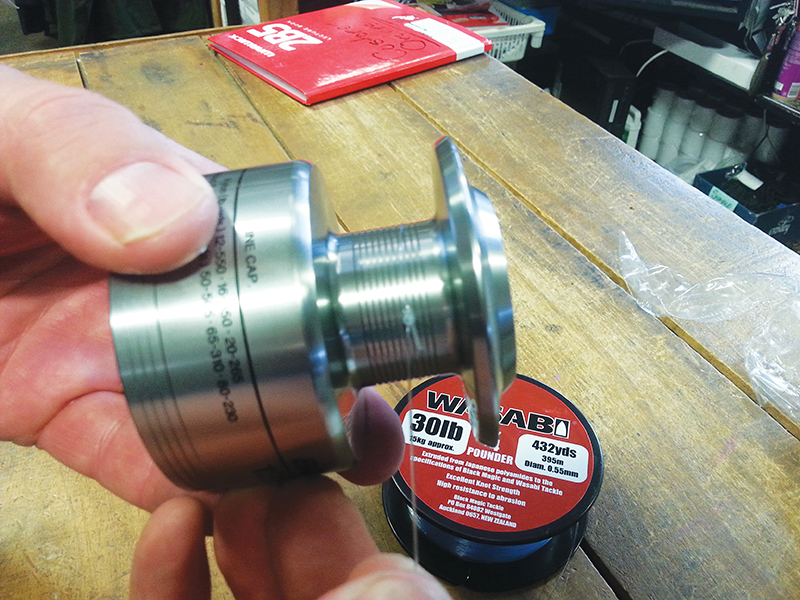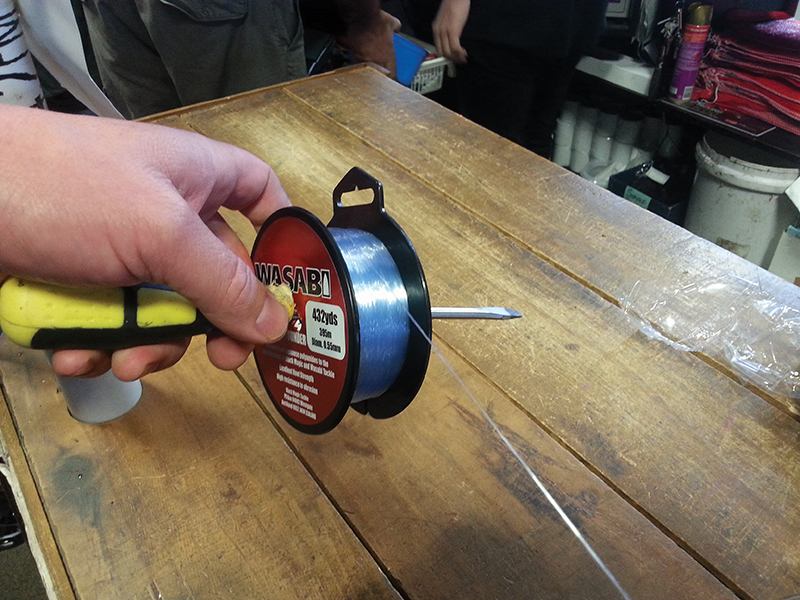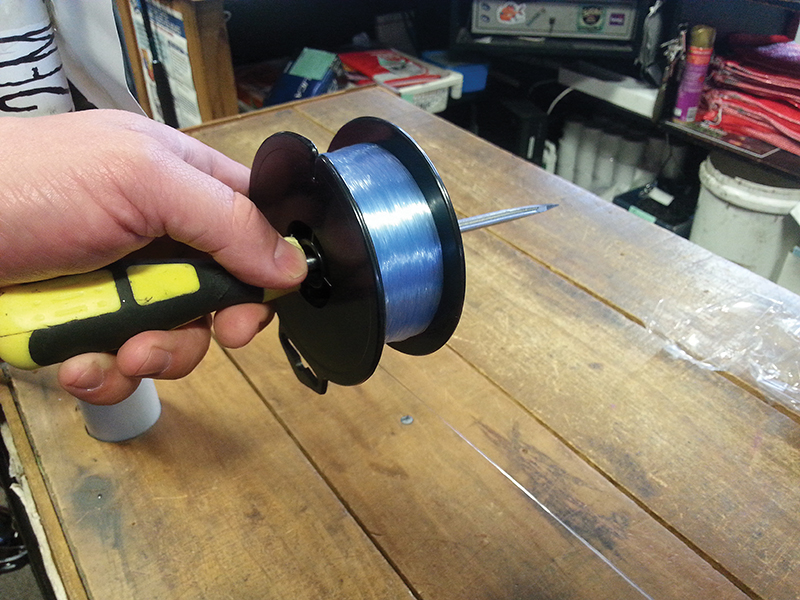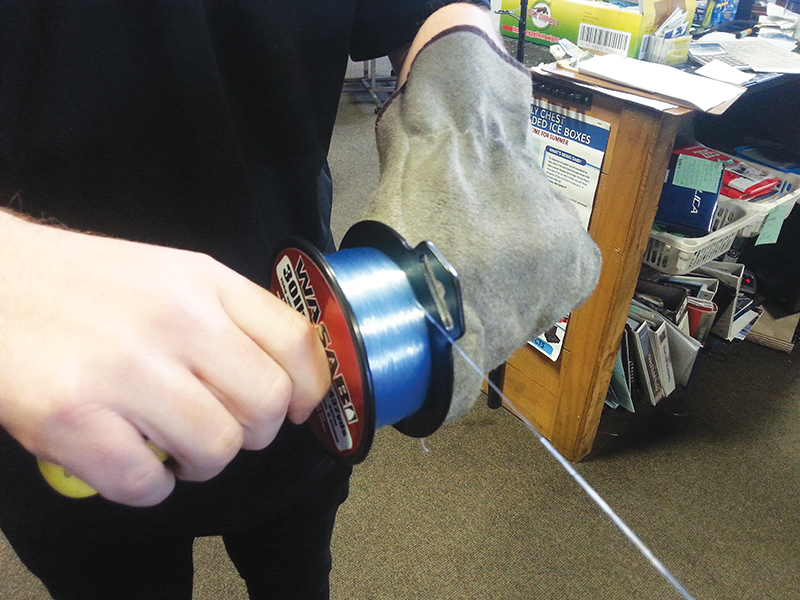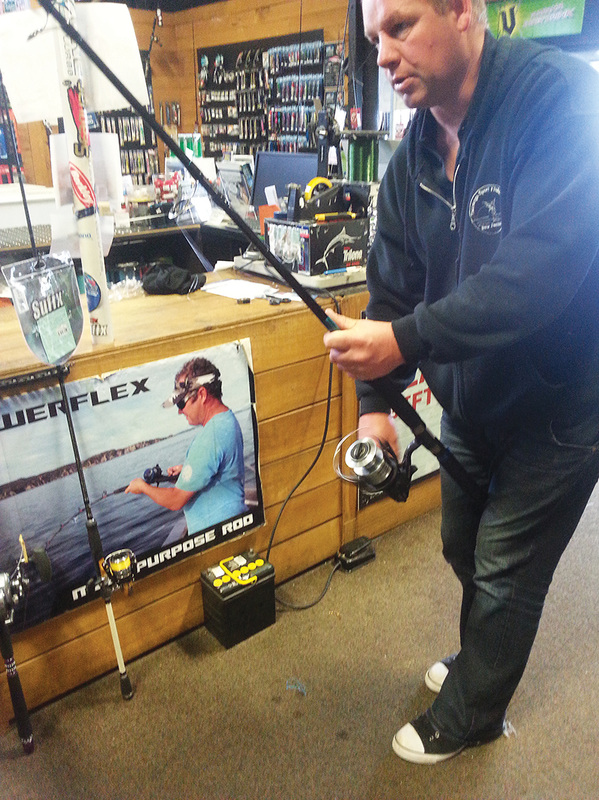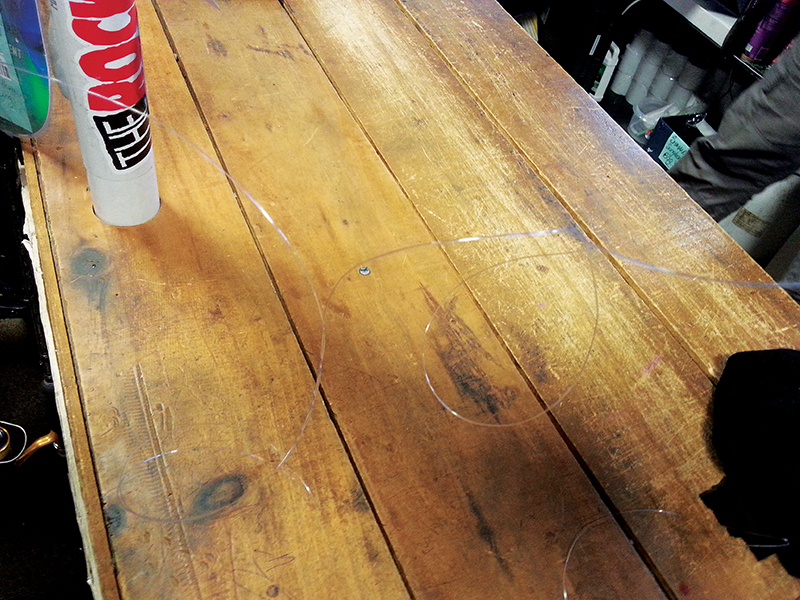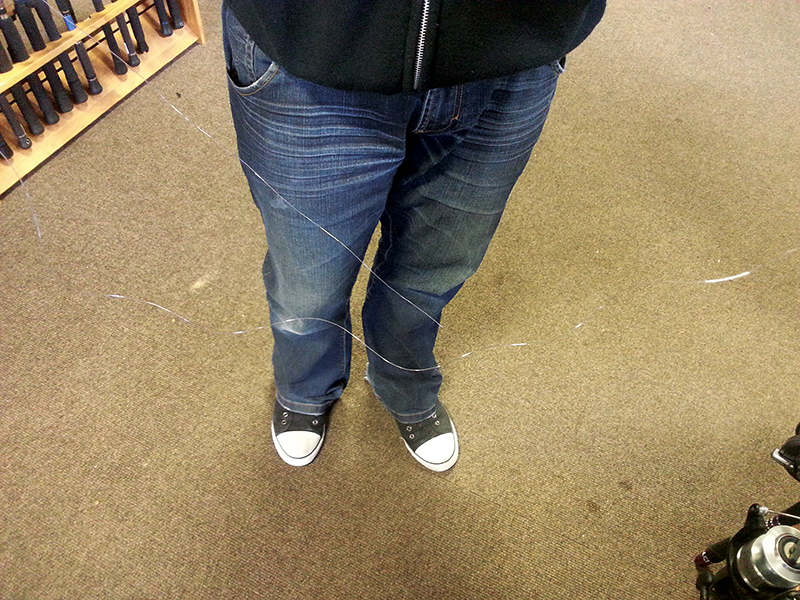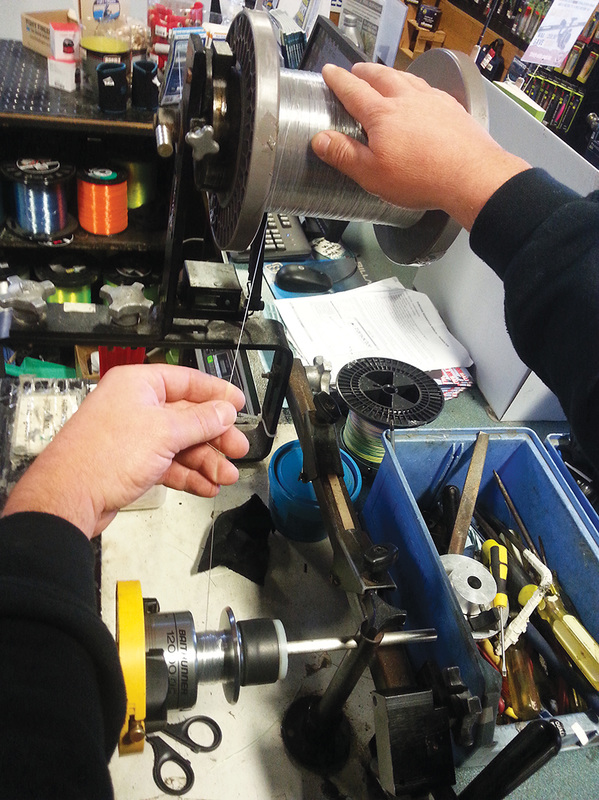tackle talk
RESPOOLING - Easy or an art??
Words and photos by Roly Bagshaw
Words and photos by Roly Bagshaw
You never know when you’ll have to load your spool with new line.
Read this article for vital know-how.
Read this article for vital know-how.
Applying the ‘she’ll be right’ attitude when it’s anything to do with fishing tackle can be likened to repeatedly pushing the buttons on the pokies. Sometimes you’ll be right, but if you’re anything like me this approach will usually end in tears. There’s nothing worse than worrying about compromised gear when you’re fighting a fish - and certainly nothing better than knowing you have done everything you can, and having confidence in your kit so you can give it heaps.
Spooling a new or secondhand reel is a task that every fisherman should learn, as you never know when you may need to do it. You may have been dusted by the Big One while on holiday, or your line may have simply faded over time; but with that comes concerns about line strength, and that’s not what you need just prior to a big trip.
Most fisherman worth their salt would agree: if your line looks dodgy get it sorted or you’ll be facing the consequences!
Spooling a new or secondhand reel is a task that every fisherman should learn, as you never know when you may need to do it. You may have been dusted by the Big One while on holiday, or your line may have simply faded over time; but with that comes concerns about line strength, and that’s not what you need just prior to a big trip.
Most fisherman worth their salt would agree: if your line looks dodgy get it sorted or you’ll be facing the consequences!
|
|
WHEN SHOULD I RESPOOL?
For mono every 2 or 3 years would be about right as a general rule, unless you’re fishing all the time. If that’s the case then respooling every year is about right - but of course some lines are better than others, and some wear much better too. You can evaluate any line simply by pulling it though your fingers. Any roughness or abrasions are signs of wear and more than likely a loss of strength has already resulted. Any shreds or bits of mono dust are also key indicators that your mono has been damaged somehow, so before you respool try and identify where the problem is coming from. Most of the time it’s a rod guide or tip that is cracked - or perhaps the insert is missing, causing scrape damage. Obviously, fix the hardware before running new line, or else the issues will just continue! Other areas to look at are a bail arm or roller malfunction in a spin reel, although in the case of an overhead reel the line damage will usually come from a malfunctioning level wind or sometimes spool bunching - due to the line not being guided on evenly; the line then rubs in the spool gap or on the frame. Maybe you haven’t used your gear in some time, or you’ve identified some damage but decided not to respool. Then the remedial approach is to rip the top 10 metres off your reel so as to expose unused line that is with any luck in much better condition than the section you removed. As the line is removed you’ll usually notice it changing colour slightly, as the sun-bleached layers uncover the more unspoilt line. If the rod and reel is a bottom fishing or strayling set there is every chance this line has been pulled through rocks and weed and been subjected to gawd knows what other abuse - so stripping it off makes sense. Off course this will probably mean the reel is not as full, but this is preferable to fishing with a weak line. Having good main line is a critical part of the ‘success’ equation when you are targeting any fish but is often not given the consideration it deserves. Many fishos will leave spooling to the local tackle shop which is a great option if you’re new to fishing. When you’re there though, don’t miss the opportunity to learn from the people there; ask lots of questions about the line you need for your requirements. Those fishing for line class records or those who fish tournaments regularly have learnt that line selection, and how the line is put on a reel, will definitely affect performance and the result. So purchasing the right mainline product for the job is important - but just as important is getting the line from the retail spool onto the reel in the best condition. Line Selection So: you’ve bought a reel; you may have purchased it as a combo or you may now need to match it to a rod. Nearly all rods have a kilo/pound rating, plus sometimes a max drag or perhaps a casting weight. Whatever the case, it should be a sufficient guide as to the most appropriate weight of line you are going to need to find in order to have a fishing set that is going to perform as it was designed. Without diving too much into the science of lines - which is a vast topic - here are a few basic considerations. If casting distance is important, lighter thinner lines will cast further; conversely, heavier lines have much better abrasion resistance but are bulkier so this in turn will affect the capacity of your outfit. More supple lines are better suited to spin reels, while stiffer lines are better used on overhead reels; this is largely to do with line memory (essentially, its springiness when on the spool). Again being guided by a pro shop will help your learning here. Mono or braid is another topic entirely but very simply: if you’re fishing deep or working/casting any lure from a rod tip, braid will most likely be your best option. Outside of this, mono will be fine and is easier to tie and work with so in many ways it’s the best starting point for a beginner. If you’re at all interested in record fishing it’s always advisable to buy IGFA-rated line. Pre-test line is usually a bit of a cheaper option however, and has been fine for line class options as the line has still been factory tested and guaranteed to break at under its rated strength. So it’s time to spool your reel, and whether or not you have a pro spooling machine your objective, and the risks to the line, are the same. Essentially the goal is to have the line (either braid or mono) loaded evenly on the spool. FIXING THE LINE The biggest danger with braid spooling is the problem of the line spinning on the spool. For any braid reels the best approach, if you don’t have a fixing point on the spool, is to either start with mono backing or use a backing tape that will allow the braid (which has next to no stretch) to adequately bind to the spool. Braid doesn’t spring and retract like mono, so using mono as a base layer has now become commonplace and has the added advantage of padding a spool so you don’t need to fill it with the much more expensive braid. Attaching your reel to a rod will make the spooling process a lot easier; now guide the line through the guides and to the reel (via any level wind). The best knots are simply a Uni knot (that’s what I have used for years) or an Arbour knot. Again where there is the ability to use a fixing point on the spool make sure you do, as it’s a safeguard, especially in braid-only situations. Winding the line on is in itself straightforward ... but there are a few key things to look out for before you start cranking flat out. Line twist can be a real problem, especially if you’re spooling a spinning reel, so it pays to do a dozen winds and then check the line. Pull a few metres back off the reel, take the ends of this section in your hands and put your hands together. Note whether the line is hanging in a lovely loop or it quickly twists up. Regardless of whether you’re spooling a spin or overhead you should always check for twist as it will almost always give you grief if you’ve got the spooling wrong. The twist If the line lays in a nice loop just continue winding it on. If it twists up however, the only thing you can do is reverse the direction of the spool the line is coming from. So if it was coming from the bottom of the spool turn the spool over so it’s coming from the top; this should sort the twist problem. However, I’ve had situations where the twist still there; this is caused by one of two things. It could be a ratio revolution issue from shop spool to your reel, or the main spool has been loaded twisted (this is more common than you’d like to think). The best thing you can do here is select the best option regarding where the line comes from (top or bottom) then finish spooling the reel. Now get yourself on the water, make sure there are no boats around, and then let the line out and troll it for a few minutes with no swivel or tackle attached. After that, wind it in slowly and you should notice it will want to find its most comfortable position on the reel, and will have no twist. How much tension? Of course the other key element of putting your line on the reel is line tension on the spool. Too little tension in either braid or mono can be a big problem as if a fish is caught immediately after the reel has been spooled and the line is loose the line peeling out will dig in to a loosely-packed spool. In the worst case this can bind and break off, making the recovery of the line end next to impossible. Where this has happened the rest of the line is often damaged too as friction burns will have played their nasty role in heating and weakening it. When spooling either mono or braid you want enough tension for the line to pack down firmly. A quick squeeze test of the spool will let you know if you have it right, as the line should not move at all. Getting tension onto a spool is as simple as applying pressure to either side of the shop spool, either with a rag or gloves. Whatever you do don’t use a rag on the line to guide it on to the reel or - worse still - use a glove or rag for putting tension on the line. This is only going to result in friction, which turns into heat which in turn will damage your line. Unfortunately this is actually the most common mistake made and it will damage every metre of line on your reel. I use my hand so I can feel any heat; that might sound strange but at least at the end of the process I know the line has been put on the reel perfectly. There’s nothing quite as easy as heading into your local fishing shop and using their expertise concerning which line is best for you, and then having the staff put it on your reel for you. However, if ever you’re in a situation where you must spool your gear yourself keep those simple tips in mind and there’s no reason why you won’t do the job just as well. |
